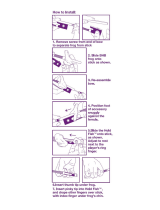
WORK MORE EFFICIENTLY IN DEVELOPMENTAL BIOLOGY WITH STEREO MICROSCOPY:
ZEBRAFISH, MEDAKA, AND
XENOPUS
2
Key Considerations for Contemporary Model Organism
Experimentation
There are three common steps when doing routine work with aquatic
model organisms, such as zebrafish:
>
transgenesis
>
fluorescent screening
>
functional imaging
A more detailed description of each work step is given in the section
below. Efficient and reliable microscopy is needed for each of these.
This sequence of steps will be referred to as “workflow” in this report.
Most countries have well defined regulations for animal safety when
used for scientific experiments. Switzerland has such regulations
as well [7]. To adhere to these regulations, it is advantageous to
have efficient and fast screening of transgenic embryos and rapid
processing of the adult zebrafish which generated the embryos.
As individual adult zebrafish cannot be permanently labeled, at least
not at the present time, males and females that are cross-bred, to
assess their embryos while screening for transgenics, need to be kept
in individual holding tanks until their embryos are well characterized.
The faster the embryos’ traits can be determined:
>
the sooner the adults can be put back into proper housing tanks
>
the number of individual tanks in the facility, and the amount of
work for the staff, can be minimized
>
and only zebrafish with the desirable traits would be maintained,
avoiding the need to keep unnecessarily high numbers of fish for
experimental work.
Faster, accurate characterization of the zebrafish embryos leads to a
more efficient, cost-effective way to maintain these model organisms.
Introduction
Among the aquatic model organisms used in biology the most
prominent are the zebrafish (genus species:
Danio rerio)
[1], medaka
or japanese rice fish (genus species:
Oryzias latipes
) [2], and african
clawed frog (genus species:
Xenopus laevis
) [3]. This report is intended
to give useful information to scientists and technicians which can help
improve their daily laboratory work by making the steps of transgenesis,
fluorescent screening, and functional imaging more efficient.
The three aquatic model organisms mentioned above, zebrafish,
medaka, and
Xenopus
, are often used in molecular and developmental
biology. An adult zebrafish is shown below.
Adult zebrafish (
Danio rerio
).
In molecular and developmental biology, these aquatic vertebrate
model organisms are widely applied to study molecular processes
of development and as disease models. To study these molecular
mechanisms, proteins of interest are fluorescently labeled and
observed in the developing organism at the cellular or sub-cellular
level over the course of hours or days [4].
All three model organisms described here can be easily bred and
maintained in a laboratory, have short life cycles, and are amenable
for genetic modifications. Examples of these modifications are the
deletion of a gene (knock-out) or the introduction of a gene (knock-in).
If an exogenous gene is introduced into the genome, the result is a so-
called transgenic organism. Below, we will focus on this method [5].
In addition, zebrafish have a specific trait that also make them useful
for developmental neuroscience: the larvae of zebrafish are semi-
transparent so the activity of multiple neurons can be measured
simultaneously during development [6].












